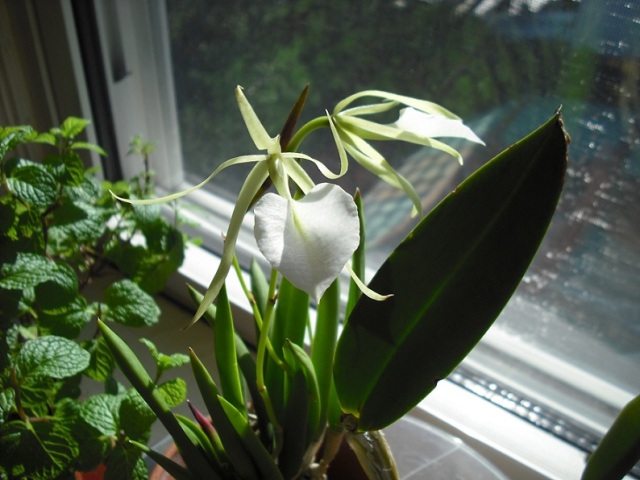QuestionQUESTION: Hi Wayne,
I purchased a pot. little fortune #15 earlier on in the summer. It grew well and put out lots of roots, but ever since it dried out completely during one weekend while I was away it hasn't really bounced back. All the pseudo-bulbs are shriveled up and there are no visible healthy roots. The new growth which started in mid summer seems to have gotten far, but has slowed down significantly before reaching the size of last year's growth.
I'm wondering what I can do at this point. I know this is a warm growing orchid, but I live in New York and all I have is a bright south-east facing windowsill that gets drafty at night that. Occasionally I move it to a warmer part of the room at night. I heard from a phal orchid professional grower that it's not good to move orchids around very much.
I'm hoping this new growth will produce at least one flower. What should I do at this point?
-Theo
ANSWER: Theo, my recollection is that this is a minicat, probably yellow with a red lip. Minicats can be very tricky to grow. Potinaras like warm temperatures and little variations in temperature and humidity, temperature and lighting. They do best in small clay pots with good drainage. To maintain a warmer temperature, you might try keeping it away from windows and use a clip on spot light of about 50 watts to provide both heat and light. It should be about 12 inches from the plant but you can monitor the temperature to try to maintain a temperature of 75-85 degrees. Keep the light duration at about 12 hours. Mist the plant once or twice per week in the morning and be sure the mix stays fairly dry between mistings.
There is a great deal of breeding occurring to produce superior minicats. Careful selection of parents is a key to this. Sunset Valley Orchids in California is one of the leaders in producing strong and floriferous minicats. Minicats have fallen into disfavor because of the kind of problems you have experienced. This situation should improve as we go forward with these improved lines of breeding. The goal is to produce strong plants with good growth habit and large flowers compared to plant size.
---------- FOLLOW-UP ----------
QUESTION: Wayne,
Now that I think of it, it did best when it was under bright indirect sunlight in the summer when indoor temperatures were around 75 degrees. I guess the New York cold is what has slowed it down. It seems like it can only be grown under green house conditions.
Would you say that the type of minicat I have is one of the more challenging types?
ANSWER: Yes, Theo I think you have one of the more challenging types. It may be a cross between Pot Little Toshie and BLC Fortune. I have found both of these crosses to be quite challenging so would not necessarily expect improvement in their offspring. Also, the fact that it has been assigned a number rather than a cultivar name means it was aassigned number as one of a whole group of this cross. Were it an exceptonal plant among plants of this cross, the hybridizer would have kept it back, named it, and had it registered.
---------- FOLLOW-UP ----------
 b. grand stars
b. grand stars
QUESTION: Wayne,
That's good to know! I'll do my best to help it survive, but I'm not sure if it'll ever flower in my house.
I purchased a b. grand stars from the same nursery several weeks ago. Luckily, when I got home I read this variety is very easy to care for, but I wanted to have your input since you are somewhat familiar with my care limitations. It's flower and I heard they like to stay dry while in flower, but I'm not sure if that's really the case since it seems to be putting out another spike and when I came home this weekend one of the new buds had shriveled. I only water it once a week. Are you familiar with brassavolas? What should I be doing with it now? It's in a tiny 3 inch pot. When should I repot it?
AnswerTheo, this is Brassavola nodosa x Brassavola Little Stars. My experience with B. nodosa is to grow it in a well-drained inorganic potting mix with light on the brighter ride and temperatures on the warm side (70-80 degrees). When it's in a well draining potting mix, it likes to be kept on the damp side with good air movement. I have a couple of dozen B. nodosa plants collected from different sites in Mexico and Central America. Even when grown in the same location, some are reluctant bloomers and others are good bloomers. Sounds like the cross you have comes from one of the better parents. Hence, so much for the myth that Brassavolas are easy to grow-- some are and some aren't. I have found good success in growing them under a 4 bulb, 4 foot florescent light. Often times, flower spikes will not emerge all at the same time. This provides a longer blooming period. In the summer, I place them outside (usually hanging). I have grown them in full sun but do not find this any better than partial sun. In nature, Brassavolas may grow on rocks where they can be wave washed by ocean water. But, some grow in very dry locations but are subject to mists.
I would repot it only after you have at least three growths growing outside the pot.






